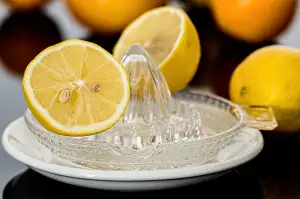Master the Art of Cleaning a Cast Iron Skillet: A Step-by-Step Guide for a Pristine Home

Cleaning a cast iron skillet may seem like a daunting task, but with the right techniques, it can be a breeze. Cast iron skillets are beloved for their durability and ability to retain heat, making them a staple in many kitchens. However, improper cleaning can lead to rust and damage. In this step-by-step guide, we will walk you through the process of cleaning your cast iron skillet to ensure it stays in pristine condition for years to come. So let's dive in and master the art of cleaning a cast iron skillet!
Gather necessary supplies for cleaning
To clean a cast iron skillet effectively, it is important to gather all the necessary supplies beforehand. Here are the items you will need:
1. Coarse salt or baking soda: These abrasive substances will help remove any stubborn food residue without damaging the skillet's surface.
2. A soft sponge or brush: Use a non-abrasive sponge or brush to scrub the skillet gently.
3. Hot water: Make sure to have hot water available for rinsing and cleaning purposes.
4. Mild dish soap (optional): While some purists prefer not to use soap on their cast iron skillets, a small amount of mild dish soap can be used if needed.
5. Paper towels or clean cloth: These will be used for drying the skillet after cleaning.
6. Cooking oil or shortening: You will need oil or shortening for seasoning the skillet after cleaning.
Having these supplies ready will ensure that you can clean your cast iron skillet efficiently and effectively, leaving it in pristine condition for future use.
Preparing the skillet for cleaning
Before diving into the actual cleaning process, it's important to prepare your cast iron skillet properly. This step ensures that any food residue or stubborn stains are easier to remove.
First, let the skillet cool down completely after use. Never attempt to clean a hot skillet as it can cause burns.
Next, scrape off any leftover food particles using a stiff brush or a plastic scraper. Be gentle yet thorough in this step to avoid scratching the surface of the skillet.
If there are any stubborn bits stuck to the skillet, you can add a small amount of water and heat it on low heat. This will help loosen the stuck-on food without damaging the seasoning.
Once you have removed all visible debris, rinse the skillet with warm water. Avoid using soap at this stage as it can strip away the seasoning. Instead, rely on good old-fashioned elbow grease and hot water.
After rinsing, inspect the skillet for any remaining residue. If needed, repeat the scraping and rinsing process until the skillet looks clean.
Now that your cast iron skillet is prepared for cleaning, you're ready to move on to the next step: actually cleaning it thoroughly.
Cleaning the cast iron skillet
Cleaning the cast iron skillet is an important step to maintain its longevity and cooking performance. Start by rinsing the skillet with hot water, using a sponge or brush to remove any food residue. Avoid using soap as it can strip away the skillet's seasoning. For stubborn stuck-on food, sprinkle salt on the skillet and scrub gently. Rinse thoroughly and dry immediately to prevent rusting. Remember, never soak the skillet or leave it wet as this can lead to rust formation.
Drying and seasoning the skillet
After cleaning your cast iron skillet, it's crucial to dry it thoroughly to prevent rust. Start by using a clean, dry cloth or paper towel to remove any excess moisture. Next, place the skillet on a stovetop burner set to low heat for a few minutes. This will help evaporate any remaining water.
Once the skillet is completely dry, it's time to season it. Seasoning creates a protective layer on the surface of the skillet and enhances its non-stick properties. To season, apply a thin layer of vegetable oil or melted shortening all over the skillet, including the handle and exterior.
Use a clean cloth or paper towel to spread the oil evenly, making sure to cover every inch of the skillet. Be careful not to use too much oil as it can become sticky. Once coated, place the skillet upside down in an oven preheated to 350°F (175°C). Leave it in the oven for about an hour.
After an hour, turn off the oven and let the skillet cool completely inside before removing it. The heat will allow the oil to penetrate into the pores of the cast iron, creating that desirable non-stick surface.
Repeat this seasoning process regularly to maintain your skillet's seasoning and prevent rust from forming. With each use and proper care, your cast iron skillet will develop a beautiful patina that enhances its cooking performance and durability.
Remember that each time you cook with your cast iron skillet, you are also adding layers of seasoning through natural oils from food. This helps build up its non-stick surface over time.
By properly drying and seasoning your cast iron skillet after each use, you'll ensure its longevity and enjoy cooking with it for years to come.
Storing the cast iron skillet properly
Storing the cast iron skillet properly is crucial to maintain its longevity and prevent rusting. After cleaning and drying the skillet thoroughly, make sure it is completely cool before storing. Avoid stacking other cookware on top of it, as this can cause scratches or damage. To prevent moisture buildup, place a paper towel or cloth inside the skillet to absorb any excess moisture. Finally, store the skillet in a dry place with good ventilation to prevent any potential rust formation. By following these storage guidelines, you can ensure your cast iron skillet remains in pristine condition for years to come.
Tips and tricks for maintaining a clean skillet
1. Avoid using soap: Soap can strip away the seasoning of your cast iron skillet. Instead, use a brush or scrubber and hot water to clean it.
2. Scrub with salt: If there are stubborn food particles stuck on the skillet, sprinkle some coarse salt and scrub gently with a damp cloth or sponge.
3. Dry thoroughly: After washing, make sure to dry the skillet completely to prevent rusting. You can place it on low heat on the stove for a few minutes or towel dry it.
4. Apply a thin layer of oil: To maintain the seasoning, rub a small amount of vegetable oil or melted shortening onto the surface after each use.
5. Store properly: Store your cast iron skillet in a dry place with good air circulation. Avoid stacking other cookware on top of it to prevent scratching.
6. Use regularly: Regularly using your cast iron skillet helps maintain its seasoning and prevents rusting. So don't let it sit unused for too long!
By following these tips and tricks, you can ensure that your cast iron skillet remains clean, well-seasoned, and ready to create delicious meals for years to come!
In conclusion, mastering the art of cleaning a cast iron skillet is essential for maintaining its longevity and ensuring delicious meals every time. By following the step-by-step guide provided, you can easily achieve a pristine home for your skillet. Remember to gather all necessary supplies, prepare the skillet properly, clean it with care, and dry and season it thoroughly. Additionally, storing the skillet in a dry place is crucial to prevent rusting. With regular maintenance and proper care, your cast iron skillet will continue to serve you well for years to come. Happy cooking!
Published: 17. 01. 2024
Category: Home



